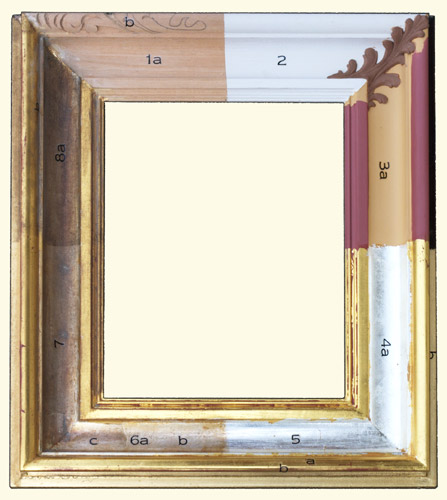What Makes a ClosedCornerFrames.com Frame Different From an Ordinary Frame?
 Move the mouse over the frame to see details of our frame finishing process.
Move the mouse over the frame to see details of our frame finishing process.An ordinary frame, also known as a "chop" frame, is usually made from mass-produced factory-finished molding that is later simply cut to size and joined together.
Frames by Edward Wright creates "closed corner" frames. After an order is placed, each frame is first cut and joined in raw wood and handcrafted from start to finish by a single artisan. The artisan of your frame uses a multi-step process of old world techniques to join, finish and gild our frames.
- 8 Steps to an Old World Finish
- Move the mouse over the frame to learn more about Frames by Edward Wright's artisan gilding and finishing techniques!
- 1. Join and Carve
- Raw basswood, a soft, straight, knot-free wood from the linden tree, is joined using wooden splines for a stable corner joint. The carve design is pencilled in using a template and handcarved.
- 2. Gesso and Sanding
- The frame is sprayed with gesso (whiting and glue) twice, and sanded following each coat, for an indiscernible corner joint.
- 3. Undercoating
- Precious metal areas are readied for gilding using yellow and then appropriate clay color.
Common metal sections are undercoated wtih appropriate dye color.
In both cases the undercoat is color coordinated to the artwork for which the frame has been designed.
- 4. Gilding
- Precious metals (gold and silver) are water gilded to the clay surface.
Common metal (brass and aluminum) is gilded using oil size.
- 5. Burnish & Rub Through
- Precious metal is burnished with an agate burnisher. Gilded areas are rubbed through to reveal the color under the leaf.
- 6. Tarnish, Spatter & Shellac
- Silver leaf is tarnished with a chemical application. Next, the surface is spattered with a mixture of shellac and rottenstone. Finally, the surface is shellacked many times to seal the leaf.
- 7. Patination
- The finish is unified with an application of hand mixed casein.
- 8. Glaze & Dust
- The frame finish is completed with a warm Raw Umber glaze. Finally, custom dust is color matched to the finish, and is applied in crevices to complete the finished look.
What distinguishes a handcrafted frame?
- The strength of splined joinery
- On each mitred frame corner we rout a slot and insert a wooden spline. We find the strength of this traditional joinery technique vastly superior to the standard nailed picture frame joint.
- Meticulous surface preparation
- Each finish requires scraping and sanding with papers of multiple grit levels. This attention to detail is necessary to prepare the wood surface for gilding.
- The adaptability of gesso surfaces
- Traditional gesso is a combination of rabbit skin glue and whiting which can be applied only when warm. The preparation and application of gesso is basic to the overall design of the frame. Areas to be given a highly burnished look must be prepared with multiple coats of gesso and meticulously sanded and polished.
- Custom undercoating
- We apply the gesso layers with various colors to complement the art work. Depending on the effect desired, these colors may be spattered, stippled or wiped onto the surface.
- Unique applications of metal leaf
- We apply an oil-based size on the colored surface to accept aluminum or brass leaf. These can be applied evenly or, for more texture, they can be crushed or cracked over the surface. One of our specialties is the combination of different leaves to achieve a unique iridescence.
- The character of tarnishing
- We have achieved some very interesting results using chemicals that react with silver leaf to enhance aspects of the artwork.
- The elegance of genuine gold leafing
- First, we brush very thin coats of rabbit skin glue mixed with clay onto the frame. This "bole" acts as an adherent for the leaf. When the clay dries, our artisans are expert gilders who float water onto small areas of the frame to activate the glue, which then accepts the gold leaf. Using a wide squirrel hair brush, the gilder carefully applies extremely thin sections of 12, 16 or 22 karat gold.
- Burnishing
- We create a mirror-like polish on carved or raised areas of the frame by burnishing the gold leaf with the rounded tip of an agate.
- The art of patination
- In patination we use various finishing techniques to bring together the surface, undercoats and leaf in the way that best complements the art work. Patination is a process of reworking the finish through distressing, glazing, steel wooling the leaf, spattering, stippling, sponging on casein, and dusting with mica powders.
- The versatility of composition
- Prepared decorative ornaments are steamed and applied to some of our frames. This allows us to create unique frame designs at a very reasonable price.
- Skilled hand carving
- For our highest quality frames, our artisans are highly skilled wood carvers who cut the appropriate ornamentation into the frame by hand.